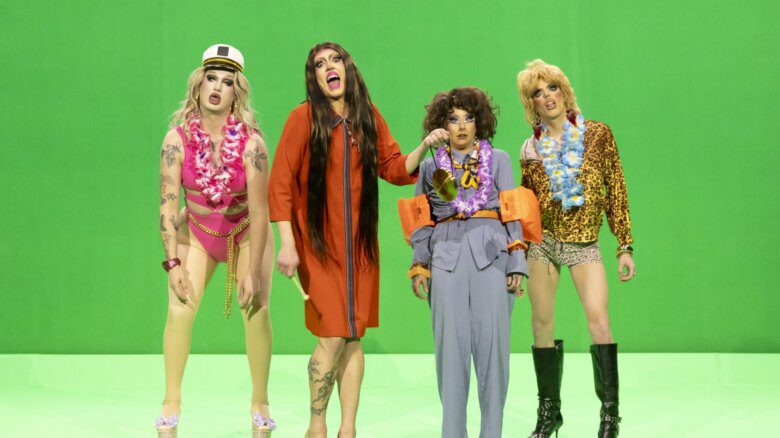Of all art media, nothing gets made fun of like performance art. To the outsider, it appears to have the least to do with learned skill and the likeliest to attract the narcissistic, the masochistic and those capable of spewing blue paint from their asshole. We all know the awful stereotype: awkward personal confession, maybe an interpretive dance or two, not much clothing and a lot of pretense. If nothing else, the Power Plant’s excellent new show, Auto Emotion: Autobiography, Emotion and Self-Fashioning, is a reminder of just how wide the gulf is between the cliché of awfulness and how fantastic performance can be. It is a brilliantly put-together — if occasionally demanding — primer on the best of performance art, an assemblage of the heights of power, affect and humour to which it can aspire.
In contrast to the haughty coolness and distance of most conceptual art, the organizing principle of this show is emotional and personal. Curators Gregory Burke and Helena Reckitt know all the right peaks to show off.
It begins with a sprawling piece by French artist Sophie Calle, Exquisite Pain, laid across two walls. Calle is famous for making grand opera out of the details of her life. Here she documents and ultimately mocks an admittedly hideous romantic split that occurred in 1984. Even after 20 years, calm retrospection is not her game. She drowns herself in memory, ultimately deconstructing her own navel-gazing, making the romantic tragedy seem silly by having it occupy so large a (physical and emotional) space. She treads a very careful highwire act, simultaneously disdaining her own narcissistic tendencies while paying homage to her genuine anguish.
Another highlight is The Onion by canonical performance art glamazon Marina Abramovic. In full Hollywood close-up, with sumptuous fuchsia lipstick, Abramovic complains, in her best Garbo pout, about almost everything in her life (“I hate my nose for being too big. I hate my ass for being too wide”) while eating an onion (skin and all) like it was an apple. Abramovic embraces the excesses of her own persona with the high seriousness of a tragedian and delivers her litany of woes like it was Shakespeare, with tears streaming down her face, her nose leaking all the while.
Local homo-made-good Benny Nemerofsky Ramsay is accounted for with two whimsical installations: Live to Tell, where he becomes a full chorus belting out an a cappella version of Madonna’s ballad to a bunch of security cameras, and Lyric, where, on four separate TVs, he creates nonsense ditties by singing a constant stream of isolated lines of pop lyrics. We hear lyrics about being with you forever, holding you in my arms, taking me higher, and so on and so forth.
Andrea Fraser’s furiously funny striptease-cum-art reception speech, Official Welcome, is nothing short of brilliant, if purely for her deliciously biting send-up of art personas encountered during said receptions.
It’s not all fun and games: Curators Burke and Reckitt are careful to address the broader spectrum of performance video by including its more severe aspects (lapsed Catholics can revel in Reza Afisina’s brutal What, where the artist viciously slaps himself while reading from the book of Luke). Still, because this is a show structured around confessionals and because most of the artists included embrace that with over-the-top excess, humour tends to be the overriding aesthetic.
Despite the propensity toward (dark) comedy, Auto Emotion is more demanding than most shows; unlike an exhibition of paintings or photographs, you can’t just breeze by the pieces. This is time-based work, and there’s not much sense in popping in and out for five minutes of a 30-minute video. Making your way through the show can be exhausting, but if you’re going to come to any understanding of performance work, it’s worth giving these artists their due.
It’s certainly worth marshalling your energies for the last work, in the upstairs gallery at the end of the hall: Christian Jankowski’s Angels of Revenge. He solicited revenge fantasies from strangers he met at a costume contest during a horror convention. Emerging from darkness in full costume, they narrate their tales of retribution as they inch towards the camera, each episode ending in a violent flash. The fantasies range from the laughably banal (an overweight werewolf blathers on with thespian gravitas about his lost cell phone), to the adorable (after being laughed at for hurting her leg, a little girl swears that, “Now, [she’s] going to bite you!”), to the profoundly disturbing (a rubber-masked man swears revenge on an assumed former lover by detailing her rape and mutilation). The video is a showstopping finish to the exhibition. It summarizes, in a crisp 11 minutes, what this show is all about and what performance can do at its best: It becomes a mirror. When that body in front of us, running through these bizarre rituals, forces our empathy and engages us on a visceral level, it reflects our fears, our concerns and our isolating capacities for ridiculous self-involvement, for humour and for terrible cruelty.

 Why you can trust Xtra
Why you can trust Xtra


